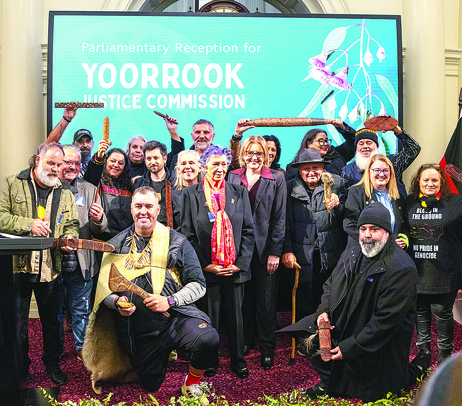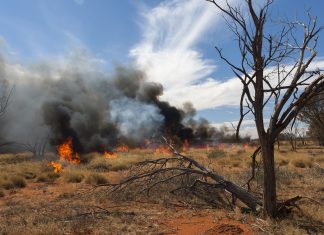By DAVID BRAITHWAITE
This report contains details of harm caused to people, as well as the names of Aboriginal people who are deceased.
THE Yoorrook Justice Commission’s final report has been tabled in state Parliament, making public its findings and recommendations a day after the historic commission wrapped up its work.
Among the recommendations are for the state government to issue an apology and for restitution be given to First Nations people.
With its release, the final report from Australia’s first formal truth-telling process, Yoorrook for Transformation provides an authoritative official public record of this state’s history since colonisation as told by First Peoples.
Included is recognition of historical massacres against Gippsland’s Gunaikurnai people.
“Victoria’s frontier delivered its own horrors. As the Eumeralla Wars were being waged in the west, across in the east pastoralist Angus McMillan and his men – the self-appointed ‘Highland Brigade’ – left a trail of blood in a series of massacres in Gippsland from 1843 onwards, in which hundreds of Gunaikurnai people were killed,” the report stated.
“The violence left no region untouched. On Gunaikurnai Country, the Warrigal Creek massacres (around Darriman) wiped out as many as 150 lives, while 15 were lost at Milly Creek (near Marlo).
“Rolf Boldrewood, a colonist and author, wrote with casual candour that ‘for one reason or other the gun was rarely a day out of our hands’. Gippsland colonist Agnes Buntine whipped Gunaikurnai people and forced them into the sea.
“Patrick Coady Buckley put a rope around a Gunaikurnai man’s neck and made him run into the surf for four hours. Cannons were fired into camps.
“Bungelene, another Gunaikurnai man, was chained to a tree outside Native Police headquarters.”
On the ‘timeline of colonisation of Victoria’, there are numerous references to incidents in Gippsland:
1840 – Angus McMillan ‘invades’ Gunaikurnai Country (present-day Gippsland); Latrobe Valley massacre; Boney Point (Lake Wellington) massacre.
1841 – Butchers Creek (near Metung) massacre.
1842 – Tambo Crossing massacre Eumeralla massacre; Hollands Landing massacre.
1843 – Grazing licences introduced to ‘preserve the rights of the Crown to the lands’; Warrigal Creek massacre; Warrigal Creek Mouth massacre; Bruthen Creek massacre; Freshwater Creek massacre; Gammon Creek massacre; Victoria Range massacre.
1846 – Snowy River massacre.
1862 – Ramahyuck Mission established by German Moravian missionaries and Presbyterians on Gunaikurnai Country at a known massacre site (Boney Point).
1908 – Ramahyuck Mission closed. Lake Tyers Aboriginal Reserve transferred to board control.
The report details the ongoing impacts of colonisation, racism and intergenerational trauma on First Peoples’ lives today and shares stories of First Peoples’ resistance, courage and survival over hundreds of years.
The report included 100 recommendations which the commission claimed “lay out a bold path for reform to create a better future for First Peoples”.
The recommendations deal with transformative change through the treaty process; self-determination, rights and accountability; reforms regarding land, education, health, housing, economic, political life and access to records, and redress.
In the recommendations, the government must “officially acknowledge the responsibility of its predecessors for laws, policies and practices which contributed to the systemic injustices against Victorian First Peoples”; make an official apology to First Peoples, and through statewide and Traditional Owner treaties, provide redress in the form of restitution of traditional lands, waters and natural resources, monetary compensation and tax relief.
Yoorrook expects the government to immediately begin work to implement the urgent recommendations so they can be achieved over the next two years.
First Peoples’ Assembly co-chairman Rueben Berg said Yoorrook’s final report showed the clear need for change in responding to issues facing First Peoples, which a treaty would deliver.
“Truth and treaty go hand-in-hand – treaty will acknowledge our shared history and be an agreement between First Peoples and the Victorian government on how we move forward together to help right past wrongs,” Mr Berg said.
“Victorians know that we can’t keep doing the same thing and expecting different results. When it comes to issues facing First Peoples, we need a different approach, one that draws on the expertise of First Peoples to design and deliver practical solutions to local challenges. That’s what Treaty is all about.”
The government acknowledged the immense undertaking of the Yoorrook commission in preparing these historic reports, and shares the commission’s goals of truth and justice and will consider the findings and recommendations.
Premier Jacinta Allan said the historic reports shined “a light on hard truths and lay the foundations for a better future for all Victorians”.
“Victoria’s truth-telling process is a historic opportunity to hear the stories of our past that have been buried – these are stories that all Victorians need to hear,” she said.
The assembly is currently negotiating the first statewide treaty agreement between First Peoples and the state government.
Later this year, the government expects to introduce the Statewide Treaty Bill to Parliament.
Negotiations on the bill are focusing on how to evolve the First Peoples’ Assembly of Victoria into an ongoing representative body to provide advice to government and make decisions over matters that affect First Peoples.
Under the Statewide Treaty bill, the proposal is for the First Peoples’ Assembly to be a statutory corporation.
Opposition leader Brad Battin said the push for a treaty would fundamentally reshape how Victorians interacted with each other.
“We currently have no details on what this bill will contain. If Labor really cared, they would be upfront with Victorians on how they intend to negotiate their treaty, ” Mr Battin said.











